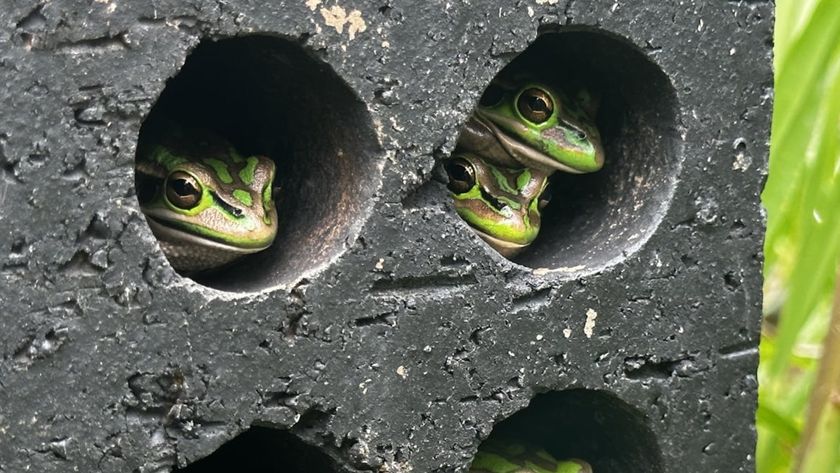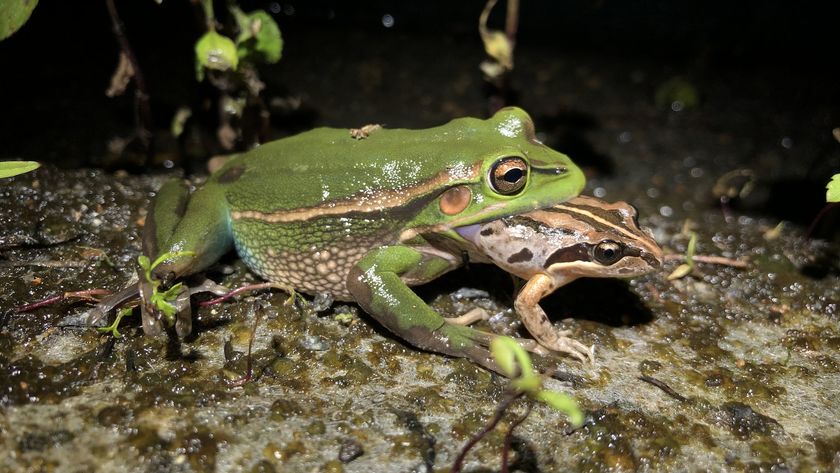Transitional Frog Lays Eggs on Water and Land

When our distant ancestors were making their way out from the water, they had to evolve a way to lay their eggs on land.
Now a tree frog could help shed light on this mysterious, pivotal moment in history. This little yellow Panamanian amphibian is the first known vertebrate that can lay its eggs both in water and on land.
The researchers looked at the hourglass treefrog (Dendropsophus ebraccatus), which is also known as the pantless treefrog because part of its leg lacks color. This amphibian typically lays its eggs on plants hanging over ponds. After tadpoles hatch, they simply fall into the water. Now Boston University scientists Justin Touchon and Karen Warkentin find these frogs can lay egg masses directly in or on ponds.
("Treefrog" refers to the family Hylidae, of which this species is a member. "Tree frog" in general refers to any frog that lives in trees.)
Stinky work
To see how these amphibians choose between laying their eggs in water or on land — and to understand the demands our distant ancestors might have faced to make this shift — the researchers investigated three ponds in Panama.
"It can be messy, dirty, stinky work," said Touchon, a behavioral ecologist. "I wouldn't say it's necessarily hard work. But you do have to wade out waist deep into these hot tropical ponds, and the mud smells awful and decaying, and deal with mosquitoes and many other biting insects."
Sign up for the Live Science daily newsletter now
Get the world’s most fascinating discoveries delivered straight to your inbox.
Two of the ponds were covered by shade from trees, and the frogs laid their eggs on the vegetation above the water. In a third pond in an old gravel quarry without a forest canopy, the vast majority of the eggs — about three-quarters — were laid in water, supported by aquatic vegetation. The other roughly one-quarter of the eggs were laid on leaves above the pond, although the mortality rate of these eggs was high due to the heat and lack of shade.
"We were in the right place at the right time to make this discovery," Touchon recalled. "We were wading into the middle of the quarry pond at night looking for frogs — there are at least 10 different species of frog there out and calling on any given night — and we happened upon a pair that was laying its eggs in the water."
Environment rules
To see if genetic differences made frogs lay eggs in water or on land, the researchers built miniature ponds in an open field and in the forest. Their findings showed that environment and not genetics was key here. Frogs placed in the shaded ponds laid their eggs above the water, and ones in unshaded ponds deposited eggs in the water.
Although humans did not evolve from frogs, our evolution does go back to other, albeit long extinct amphibians. Our remote ancestors might have evolved reproduction on land to escape aquatic predators or to cope with alterations in the environment just as these treefrogs do, improving their chances of surviving changes in habitat or climate.
"Hopefully understanding what drove the evolution of reproduction on land will give clues to what led the movement out of the water in general by all animals," Touchon told LiveScience.
It turns out the eggs of these frogs are not ideally suited for either land or water. Eggs in the water have the challenge of getting enough oxygen, while eggs on land risk drying out, among other things. "They're not as good at surviving on land or in the water as eggs specialized for either, but they can do both," Touchon noted.
The most surprising thing about this discovery of an animal that can lay eggs both aquatically and terrestrially "is that nobody has actually seen something like this before," Touchon said. "Terrestrial egg-laying has evolved many times in frogs, so there might be multiple transitional species capable of both aquatic and terrestrial breeding. It was probably because no one had thought to look for such transitional species before — until now, it was always thought frogs were either aquatic or terrestrial breeding."
Evolution key
Knowing about these frogs gives researchers "the first opportunity to test the different ideas regarding the evolution of terrestrial breeding," Touchon explained. "We could conduct experiments manipulating the aquatic environments or the terrestrial environments and see how that affects the survival of eggs in either environment — change the predators, for instance, or the humidity."
And while this frog is the first vertebrate known that can lay its eggs both in water and on land, the researchers emphasize that it is probably not alone. The researchers plan to investigate closely related frogs. It may turn out this might not be limited to amphibians — quite a few fish are known to lay their eggs outside of the water, and it's very possible that some of those species can lay both in and out of water as well, Touchon said.
Discovering other animals capable of both aquatic and terrestrial breeding is important "because terrestrial breeding has evolved so many times, it will be interesting to see if the same factors were involved, or perhaps different ones, to hopefully turn up more pieces of the puzzle," Touchon said.
Touchon and Warkentin detailed their findings online May 19 in the journal Proceedings of the National Academy of Sciences. Their research was funded by the National Science Foundation, Boston University, the Smithsonian Institution and The Animal Behavior Society, and supported by the Smithsonian Tropical Research Institute.
- Key Moments in Human Evolution
- Vote: The World's Ugliest Animals
- Image Gallery: Amphibian Tree of Life



